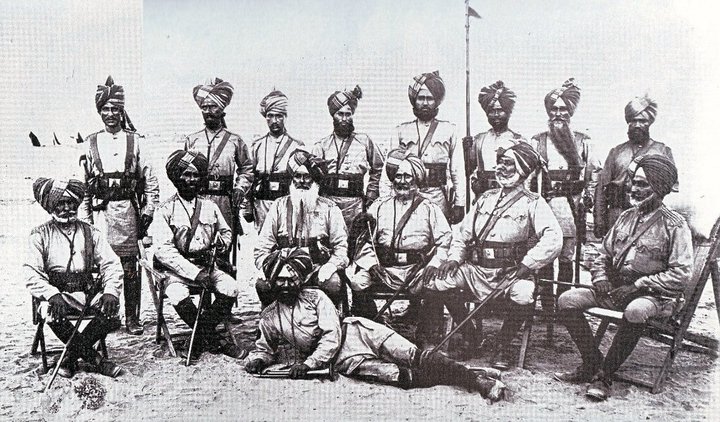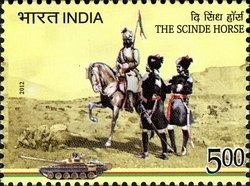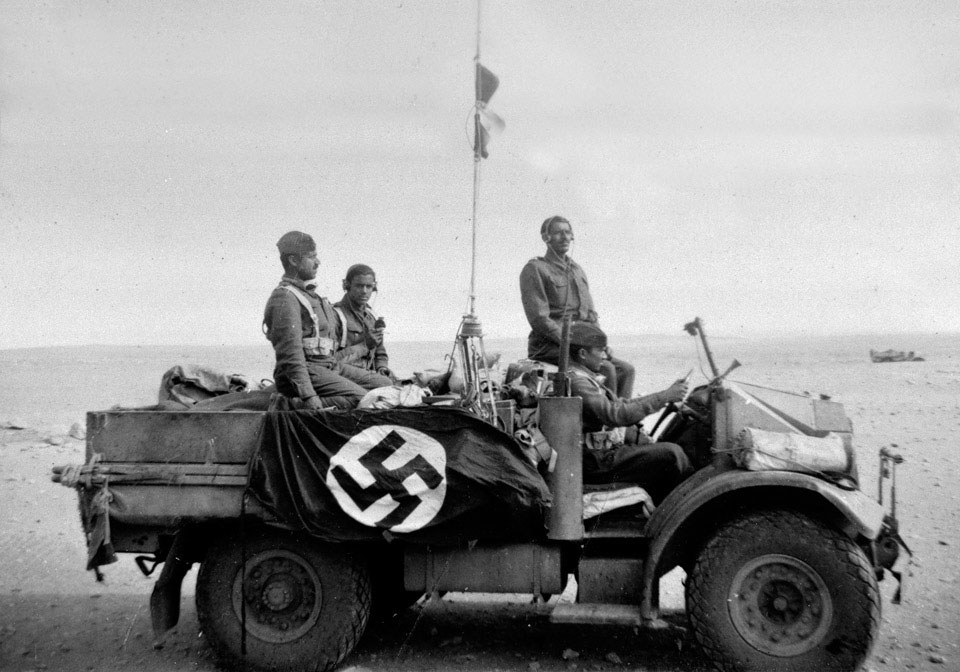|
12th Indian Cavalry Brigade
The 12th Indian Cavalry Brigade was a cavalry brigade of the British Indian Army that formed part of the Indian Army during the First World War. It remained in India throughout the war. History The 12th Indian Cavalry Brigade was formed under 4th (Quetta) Division in June 1918. It took command of three newly formed cavalry regiments: * 40th Cavalry formed in April 1918 from **a Squadron (army), squadron of 1st Duke of York's Own Lancers (Skinner's Horse) **"A" Squadron and two half squadrons of 3rd Skinner's Horse **another squadron * 41st Cavalry Regiment, 41st Cavalry formed in April 1918 from **"F" Squadron, 26th King George's Own Light Cavalry **"F" Squadron, 39th King George's Own Central India Horse **a squadron of 15th Lancers (Cureton's Multanis) **a squadron of 37th Lancers (Baluch Horse) * 42nd Cavalry formed in April 1918 from **"F" Squadron, 35th Scinde Horse **a squadron from the depot of the 10th Duke of Cambridge's Own Lancers (Hodson's Horse) **two other squadro ... [...More Info...] [...Related Items...] OR: [Wikipedia] [Google] [Baidu] |
British Crown
The Crown is the state (polity), state in all its aspects within the jurisprudence of the Commonwealth realms and their subdivisions (such as the Crown Dependencies, British Overseas Territories, overseas territories, Provinces and territories of Canada#Provinces, provinces, or states and territories of Australia, states). Legally ill-defined, the term has different meanings depending on context. It is used to designate the monarch in either a personal capacity, as Head of the Commonwealth, or as the king or queen of their realms (whereas the monarchy of the United Kingdom and the monarchy of Canada, for example, are distinct although they are in personal union). It can also refer to the rule of law; however, in common parlance 'The Crown' refers to the functions of executive (government), government and the civil service. Thus, in the United Kingdom (one of the Commonwealth realms), the government of the United Kingdom can be distinguished from the Crown and the state, in prec ... [...More Info...] [...Related Items...] OR: [Wikipedia] [Google] [Baidu] |
41st Cavalry Regiment
The 41st Armoured Regiment is part of the Armoured Corps of the Indian Army. History 41st Cavalry Regiment During World War I, a regiment named the 41st Cavalry Regiment was raised at Baleli by Major John Hope Hallowes of the 15th Lancers (Cureton's Multanis). Besides the Commandant, no other officer was posted until 17 July 1918 when the regiment became active. In August 1918, two squadrons of the newly formed regiment were sent to patrol the East Persia Cordon. 41st Cavalry Regiment was raised from a squadron from Hallowes' own regiment, the Cureton's Multanis, and one squadron each from the 26th King George's Own Light Cavalry, 37th Lancers (Baluch Horse) and from the 39th Central India Horse. The ethnic composition was as follows: * Pathans – one squadron. * Sikhs – one squadron. * Derajat Muslims – one squadron. * Punjabi and Rajput Muslims – half squadron each. Formation Drawing lineage from a cavalry regiment that existed between 1918 and 1921, the regimen ... [...More Info...] [...Related Items...] OR: [Wikipedia] [Google] [Baidu] |
Brigades Of India In World War I
A brigade is a major tactical military formation that typically comprises three to six battalions plus supporting elements. It is roughly equivalent to an enlarged or reinforced regiment. Two or more brigades may constitute a division. Brigades formed into divisions are usually infantry or armored (sometimes referred to as combined arms brigades). In addition to combat units, they may include combat support units or sub-units, such as artillery and engineers, and logistic units. Historically, such brigades have sometimes been called brigade-groups. On operations, a brigade may comprise both organic elements and attached elements, including some temporarily attached for a specific task. Brigades may also be specialized and comprise battalions of a single branch, for example cavalry, mechanized, armored, artillery, air defence, aviation, engineers, signals or logistic. Some brigades are classified as independent or separate and operate independently from the traditional div ... [...More Info...] [...Related Items...] OR: [Wikipedia] [Google] [Baidu] |
List Of Indian Army Brigades In World War I
A ''list'' is any set of items in a row. List or lists may also refer to: People * List (surname) Organizations * List College, an undergraduate division of the Jewish Theological Seminary of America * SC Germania List, German rugby union club Other uses * Angle of list, the leaning to either port or starboard of a ship * List (information), an ordered collection of pieces of information ** List (abstract data type), a method to organize data in computer science * List on Sylt, previously called List, the northernmost village in Germany, on the island of Sylt * ''List'', an alternative term for ''roll'' in flight dynamics * To ''list'' a building, etc., in the UK it means to designate it a listed building that may not be altered without permission * Lists (jousting), the barriers used to designate the tournament area where medieval knights jousted * ''The Book of Lists'', an American series of books with unusual lists See also * The List (other) * Listing (di ... [...More Info...] [...Related Items...] OR: [Wikipedia] [Google] [Baidu] |
12th Cavalry Brigade (British Indian Army)
The North Midland Mounted Brigade (later numbered as the 22nd Mounted Brigade) was a yeomanry brigade of the British Army, formed as part of the Territorial Force in 1908. It served in the Sinai and Palestine Campaign in the First World War. In April 1918, it was merged with elements of the 2nd (Sialkot) Cavalry Brigade to form 12th Cavalry Brigade. It remained in Palestine after the end of the war on occupation duties. Formation Under the terms of the Territorial and Reserve Forces Act 1907 (7 Edw.7, c.9), the brigade was formed in 1908 as part of the Territorial Force. It consisted of three yeomanry regiments, a horse artillery battery and ammunition column, a transport and supply column and a field ambulance. As the name suggests, the units were drawn from the northern part of the English Midlands, predominantly Leicestershire, Lincolnshire and Staffordshire. First World War North Midland Mounted Brigade The brigade was embodied on 4 August 1914 and assigned to Third ... [...More Info...] [...Related Items...] OR: [Wikipedia] [Google] [Baidu] |
Brigadier-General
Brigadier general or Brigade general is a military rank used in many countries. It is the lowest ranking general officer in some countries. The rank is usually above a colonel, and below a major general or divisional general. When appointed to a field command, a brigadier general is typically in command of a brigade consisting of around 4,000 troops (four battalions). Variants Brigadier general Brigadier general (Brig. Gen.) is a military rank used in many countries. It is the lowest ranking general officer in some countries, usually sitting between the ranks of colonel and major general. When appointed to a field command, a brigadier general is typically in command of a brigade consisting of around 4,000 troops (four battalions). In some countries, this rank is given the name of ''brigadier'', which is usually equivalent to ''brigadier general'' in the armies of nations that use the rank. The rank can be traced back to the militaries of Europe where a "brigadier general ... [...More Info...] [...Related Items...] OR: [Wikipedia] [Google] [Baidu] |
10th Duke Of Cambridge's Own Lancers (Hodson's Horse)
4th Horse (Hodson's Horse) is a part of the Indian Army Armoured Corps, Armoured Corps of the Indian Army, which had its beginnings as an irregular cavalry regiment during the time of the Indian Rebellion of 1857. Formation The regiment was raised during the turbulent times of the Indian Rebellion of 1857. During the siege of Delhi, on 19 May 1857, an order was issued by the Commander-in-Chief, India, Commander-in-Chief, Major General George Anson (British Army officer, born 1797), George Anson to appoint Lieutenant (later Brevet (military), Brevet Major) William Stephen Raikes Hodson as the Commandant of a corps of Irregular Horse, which he was directed to raise, while at Karnal, Kurnaul. Hodson sought assistance from Robert Montgomery (colonial administrator), Robert Montgomery, Judicial Commissioner of the List of governors of Punjab (British India), Punjab. Montgomery asked two Sardar, Sirdars to raise a rissalah (troop) each, and he raised one himself. The three rissalahs l ... [...More Info...] [...Related Items...] OR: [Wikipedia] [Google] [Baidu] |
35th Scinde Horse
The Scinde Horse is an armoured regiment in the Armoured Corps of the Indian Army. The regiment, known before independence as the 14th Prince of Wales's Own Scinde Horse was a regular cavalry regiment of the Bombay Army, and later the British Indian Army. Scinde Horse is the only regiment known to honour its enemy till date (the Baluchi warrior on its badge) and has not changed its badge since its raising. At one point, the regiment carried nine Standards while on parade (regiments normally hold one), a unique privilege given to it for its valour. The regiment was the first Cavalry unit in the British Indian Army to get mechanized (at Rawalpindi, in 1938). It was also the first Cavalry regiment to get the President of India's Standard after independence. Formation The regiment can trace its formation back to The Scinde Irregular Horse raised at Hyderabad on 8 August 1839. The regiment was raised at the recommendation of Colonel Henry Pottinger, the Resident at Scinde. The first ... [...More Info...] [...Related Items...] OR: [Wikipedia] [Google] [Baidu] |
42nd Cavalry
42nd Armoured Regiment is an armoured regiment of the Indian Army Armoured Corps of the Indian Army. Formation The current regiment was raised with an "all India class" composition at Babina on 1 January 1981 by Lieutenant Colonel (later Brigadier) Ranjit Talwar (formerly of 18 Cavalry). The first Colonel of Regiment was Lieutenant General G. S. Klair, AVSM. The regiment has served in many different locations, but mostly across Northern India locations like Ambala, Jalandhar, Lucknow, Babina, Barmer and Amritsar. Prior to World War II, regiments of similar names existed. 42nd Cavalry Regiment (1918-1921) During World War I, a regiment named the "42nd Cavalry Regiment" was raised at Baleli by Maj Percy Henry Mitchell Taylor of the 32nd Lancers.Nath (2009), pg 281. The Regiment was raised from a squadron from 10th Lancers (Hodson's Horse) and the 35th Scinde Horse. The ethnic composition was as follows:- * Pathans - half squadron. * Sikhs - one and three quarter squadrons. ... [...More Info...] [...Related Items...] OR: [Wikipedia] [Google] [Baidu] |
37th Lancers (Baluch Horse)
The 15th Lancers (Baloch) is an armoured regiment of the Pakistan Army. It was formed in 1922 by the amalgamation of the 17th Cavalry and the 37th Lancers (Baluch Horse).Ahmad, Lt Col RN. (2010). ''Battle Honours of the Baloch Regiment''. Abbottabad: The Baloch Regimental Centre. Predecessor regiments 17th Cavalry The 17th Cavalry was raised in 1857 at Muttra by Colonel CJ Robarts and was composed entirely of Afghans. Throughout its existence, the regiment remained an exclusively Muslim unit. In 1861, after several changes in nomenclature, it was designated the 17th Regiment of Bengal Cavalry. In 1865, it saw action as part of the Bhutan Field Force, while in 1879–80, the regiment operated on lines of communication during the Second Afghan War as part of the Kabul Field Force. During the First World War, it dispatched a squadron to Africa where it took part in the East African Campaign. In 1919, the regiment fought in the Third Afghan War. The regiment maintained a mounted pipe b ... [...More Info...] [...Related Items...] OR: [Wikipedia] [Google] [Baidu] |
15th Lancers (Cureton's Multanis)
The 15th Lancers (''Cureton's Multanis'') was a cavalry regiment of the British Indian Army which existed from 1858 to 1921. Raised during the 1857 uprising, the regiment later saw service in the Second Afghan War of 1878–80 and the First World War. The regiment was one of the single class regiments, with all troops being recruited from the Punjab. Cureton's Multanis had a blue uniform with scarlet facings. The badge comprised two crossed lances and a pennon with a star and crescent. The star was placed over the point of crossing of the lances and was inscribed with "XV". The crescent was placed lower down and had the words "CURETON"S MOOLTANEES" inscribed upon it. The regiment had a tradition of giving a Muslim salute, i.e. ''salaam'', a gesture of obeisance, instead of the regulation military salute. This departure from military regulations was permitted them by the Lord Napier of Magdala. Early history During the Second Anglo-Sikh War, risalas of 15th Lancers horsem ... [...More Info...] [...Related Items...] OR: [Wikipedia] [Google] [Baidu] |
39th King George's Own Central India Horse
The Central India Horse (formerly the 21st King George V's Own Horse, also known as Beatson's Horse) was a regular cavalry regiment of the British Indian Army and is presently part of the Indian Army Armoured Corps. Formation The regiment was raised as two irregular cavalry regiments at the outset of the Indian Rebellion of 1857. The first regiment was formed by Captain Henry Otway Mayne on 15 December 1857 and was known initially as Mayne's Horse. Captain Mayne who was from the 6th Madras Light Cavalry and a Brigade Major of the Hyderabad Contingent, raised his regiment with troops from Gwalior Contingent, Malwa Contingent Cavalry and Bhopal Contingent. The second regiment was known as Beatson's Horse. It was raised between February and September 1858 in Hyderabad by Lieutenant Colonel (later Major-General) William Fergusson Beatson, originally of the Bengal Native Infantry. The troops were from Hyderabad. They were based at the towns of Augur in Western Malwa and Goona i ... [...More Info...] [...Related Items...] OR: [Wikipedia] [Google] [Baidu] |
.jpg)



%2C_36_Jacob's%2C_35_Scinde.jpg)
.jpg)
